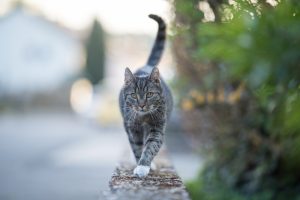MONTEREY — From touching up paint jobs before opening for the day to caring for the animals and doing repair work when things do go wrong, there’s always work to be done at the Monterey Bay Aquarium. It’s just that the Aquarium staff would rather you didn’t pay attention to that.
“Something that we try to do wherever we possibly can is to keep our maintenance activities away from the public so we don’t spoil the experience for folks,” said Paul Clarkson, the Aquarium’s director of husbandry operations. “So just like any business, we’re trying to get ready for the customers in the morning.”
But the Aquarium has a lot of challenges other businesses don’t have and it starts with the maintaining the exhibits.
Creating a successful exhibit
The machine that simulates the ocean current for the Kelp Forest exhibit has been running since the Aquarium first opened, 40 years ago. (Arianna Nalbach – Monterey Herald)
Related Articles
Tiger Woods opening his first golf apparel pop-up shop at Pebble Beach
Monterey Bay Aquarium’s Seafood Watch: A fixture in the conversation about sustainable seafood
Going against the current: What separates Monterey from other aquariums
Monterey Bay Aquarium: Providing otter love through surrogacy program
California’s first new national marine sanctuary in 32 years to ban offshore oil drilling along 100 miles of coastline
“Nature is very complex, and you find when you’re trying to recreate living exhibits how complicated it is,” said Aquarium co-founder Julie Packard. “There’s no way you can replicate the actual situation that exists out in nature, so you have to figure out what are the most critical elements.”
The Kelp Forest, the unprecedented exhibit near the Aquarium entrance, posed an interesting challenge. Packard explained they had to decide how big and deep to make the tank, how much water motion there should be and how much current the kelp plants would need to effectively simulate the ocean. A large wave machine is still used for the exhibit 40 years later.
The layout of all of the tanks and building anatomy has to be taken into account when creating new exhibits, too, so guests can have the best viewing experience.
For the Kelp Forest, “you want maximum sunlight but you need it to be oriented in a way so it maximizes sunlight,” Packard said, “but then you don’t want sun coming in through the acrylic windows so visitors can’t see into the tank.
“Reflections in aquarium designs are a huge problem, including in the dark spaces, where if you have a bright tank across the hall from another bright tank, they’re going to be just reflecting on each other,” Packard explained. “So you have to be very exact about the placement of all of that.”
Daily aquarium maintenance
Throughout the week, divers – mostly volunteers – are sent into the tanks to scrub and clean prior to opening. For the sea otter exhibit, the otters are taken into a separate holding pool behind the visitor-facing exhibit to allow the divers to work.
“They’ve been trained to move into their holding pool, and they love hanging out in their little spa back there,” said Clarkson.
The maintenance demands don’t stop for exhibits without the water, either. Every morning, crew members will head to the aviary exhibit, either adding in new plants or cleaning up and checking on the birds.
“Shorebirds are super, super sensitive,” Clarkson explained. “So any sort of debris that was here from visitors or their own waste might bring health issues. This is our time to really get in there and get this whole thing polished up.”
For the birds, the mornings before opening also provide an opportunity for Aquarium staff to provide medical care they aren’t able to do during the public hours of 10 a.m. – 5 p.m.
The work still doesn’t stop outside of the exhibits with animals.
“Oftentimes we’ll have folks not only touching up the things that are underwater, but things out of the water, too. So we have a painter in here right now,” Clarkson said recently, gesturing over to a woman painting the kids’ play area, “and she’s touching up all the artwork that’s inside the tunnel that obviously gets a ton of kid traffic.”
More complex maintenance, like electrical work, takes more time than touching up paint.
“It’s difficult to get in kind of big maintenance activities on the electrical work. So a lot of that stuff goes on really early in the morning or late at night, sometimes in the wee morning hours,” Clarkson said.
Animal care
Sea otters are relocated to a holding pool in the morning, allowing scuba divers the opportunity to clean the tank. (Arianna Nalbach – Monterey Herald)
Although staff check animals each morning, sometimes the animals need more thorough examinations.
Throughout the day, veterinary staff will perform these various procedures on the animals. For example, on a recent morning, Dot, the cusk eel, received an endoscopy to investigate something that came up on an X-ray.
Illustrations
In the jellyfish lab, Aquarium employees are able to monitor the jellies and prepare their food. (Arianna Nalbach – Monterey Herald)
Through an internship program at Cal State Monterey Bay, students have the opportunity to get hands-on experience producing science illustrations that benefit the Aquarium.
“It’s been remarkable, and it’s been really helpful for us because a lot of these animals simply don’t have really good scientific illustrations that are yet available out there in the literature,” Clarkson said. “So it allows our veterinary team to have drawings that they can use and reference for the medical care and communications back and forth with our staff. So it’s a pretty fantastic little connection there.”
Jellyfish, in particular, were interesting for the Aquarium to learn how to care for and exhibit – they were the first in the country to exhibit them.
“We’ve innovated and developed a lot of the ways in which you exhibit them and hold them,” Clarkson said. “In order to keep a jelly healthy, you have to essentially make the jelly feel like it’s in the open ocean because they’re not used to walls or the bottoms (of tanks). Most of them are swimming in endless water for their entire lives.
“So the jelly team back in the ’80s worked with an oceanographer to actually develop this type of tank, which is very unique and not a similar tank to what you keep a standard fish in that allows water to move around and keep the jellies continuously suspended as if they’re in the open ocean.”
When things do go wrong
A juvenile male great white shark in the Outer Bay exhibit at the Monterey Bay Aquarium in September 2006. (Vern Fisher/Monterey County Herald)
Prior to opening, there were many challenges the aquarium team had to tackle, stressing the importance of animal care, animal wellbeing and the seawater systems.
“There were so many unknowns and things that we were struggling with that we weren’t sure would work,” Packard said.
Thinking back on the big complications the aquarium encountered, outside of the obvious answer of the COVID-19 pandemic, Packard remembered the open sea wing located to the right of the aquarium from the entrance.
“It was designed largely around being able to keep pelagic fishes like tunas that know no boundaries where they live,” she said. Eventually, they landed on lining the tank with little glass tiles for their longevity.
“But the tunas got so big, and they would swim close to the wall. The wall actually was a thin shell. We had water behind it, and the concrete structure. They caused movement in the shell and the tiles started popping off, which was a big problem,” Packard said. “We needed to fix that because that’s dangerous for the animals.” Turtles could have eaten the tiles, or the wall could have failed by getting a tear and animals could have been trapped behind it.
Packard explained they had to close the exhibit, drain the tank and move all the animals to temporary holding while engineering a new solution with fiberglass to fix it.
Clarkson also recalled a time when the rock wall in the Kelp Forest had to undergo major repairs.
“The original rockwork wall was created 40-some-odd years ago. During our closure at COVID time… a 10-foot section of this concrete wall fell off, cracked off and came smashing down to the bottom of the exhibit,” he said. Staff realized there was deterioration in the wall and they would have to replace it.
Clarkson explained that typically when public aquariums need to undergo maintenance like that, all of the animals would be removed from the habitat, the water would be drained and the replacement would be done in a dry environment. Monterey, of course, is no ordinary aquarium and took a different approach as they were gearing up to reopen to the public.
“So with some external partners, we innovated a process where we actually repaired the thing entirely underwater. We didn’t drain a drop of water out, we didn’t remove a single animal and did all of the construction underwater,” he said. “Most of it happened while we were open to the public.”
The entire reconstruction of the wall took place underwater, including new materials and concrete that cures underwater, which is “not typically the way that public aquariums do work like this, that we’re pretty confident that other aquariums are going to probably start to pick up on and use.
“That’s a huge part of what we’re doing right now, 40 years later is, how do you keep this beautiful place in tip-top shape?” Clarkson asked. “There’s a lot of kinds of maintenance and repair and investment and innovation that goes into just keeping this place together.”












